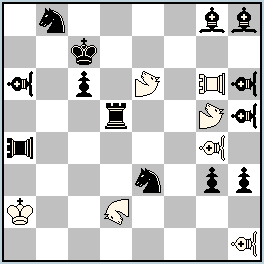|
Original Problems, Julia’s Fairies – 2014 (II): May – August →Previous ; →Next ; →List 2014(II) Please send your original fairy problems to: julia@juliasfairies.com |
No.546 by Franz Pachl – Chinese Roses in a complicated cyclic play with three phases! (JV)
No.546.1 by Franz Pachl – An improvement to No.546 created after comments. By author’s words: “It is right, what Nikola says, VAh1 is completely superfluous in 2 solutions. And also it is right, what Seetharaman says, without wVah1 and bPb7 the BRd5 moves can be pure selfblocks!” (JV)
Definitions:
PAO(PA): Chinese piece operating along Rook lines: moves as Rook, but captures only by hopping over a hurdle to any square beyond.
VAO(VA): Chinese piece operating along Bishop lines: moves as Bishop, but captures only by hopping over a hurdle to any square beyond.
NAO(NA): Chinese piece operating along the lines of Nightrider: moves along straight lines with squares lying a Knight’s move away from each other, but captures only by hopping over a hurdle to any square beyond.
RAO(RA): Chinese Rose – moves as NAO, but on Rose’s lines (Rose=(1,2)Octagonal Rider: extents the move of the Knight on a circular path e.g. a4-b6-d7-f6-g4-f2-d1-b2 or a4-c5-e4-f2).
|
No.546 Franz Pachl
Germany
original – 20.05.2014
 h#2 3 solutions (7+13) h#2 3 solutions (7+13)PAOs: g6, a4 VAOs: g4, a6, h1, h6, h5 NAO d2 RAOs: e6, g5 Solutions: (click to show/hide)
|
No.546.1 Franz Pachl
Germany
Version of No.546 – 21.05.2014
 h#2 3 solutions (6+14) h#2 3 solutions (6+14)PAO: g6 a4 VAO: g4 a6 h6 h5 NAO: d2 RAO: e6 g5 Solutions: (click to show/hide)
|




Fantastic cycle in the idea.
wVAh1 could be only artificially justified by adding bPa5 but there are more acceptable possibilities.
Complex and matched arrival effects on c4 and e6..
Matrix reminds one of Loustau’s 125 in JF-2012..
Arrival on c4 required to guard b6..
Arrival on e6 required to fire the Chinese rose anti-battery..
Removal of Rd5 required to guard b7..
The BRd5 has to also block one of the 3 flights d6/d7/d8..
Bl’s 1st move determines on which square the Chinese rose should sit on.. this in turn determines which piece will go to e6.. and in turn which flight the BR will block..
Their is actually a tertiary arrival correction on c4 with the following cumulative effects:
– guard of b6/closure of line a4-f4/closure of line a6-e2..
the defensive effects being:
– guard of f4/guard of e2..
I looked for a similar thing on e6.. but it isn’t there..
Overall, a very fine combination of line closing, opening, self blocks, triple avoidance and correction effects..!
Despite presence of varieties of Chines pieces the problem shows easily understandable cyclic effects nicely explained by Shankar. Three different blocks on c4 by black beautifully differentiate the different white anti battery effects on e6. The triple avoidance at each stage is top class!
It seems that Vaoh1 can removed by adding black pawn b7. An additional black pawn on c5 instead of the black knight e3, can give the third solution! Of course the line opening effect of the BRd5 moves will be lost. I dont see why that effect is necessary as the BRd5 moves can be pure selfblocks.
On the diagram a black Rook c8 is removed by author’s request (the problem is C+ without it).
RAg5 guards b7, so VAh1 is completely superfluous in 2 solutions. bPs b7,c5 is one way to correct it. bPa5 would close the line of RA (g5-b7) and give a function to VAh1, if that departure effect of Rd5 is so dear.
The position has some more possibilities:
– Bl. cannot interchange his moves by playing the R first.. since the wRAe6 would then be pinned by the BBg8.. so, in effect, the Bl moves to c4 act like an anticipatory unpin of the wRAe6..
– If the BBg8 were replaced with a BVao, then we would have the addition of the black moves being checks, parried by white in a chinese specific way.. this would be provided BRd5 were forced to make the 1st move.. seems difficult.. someone can try..!